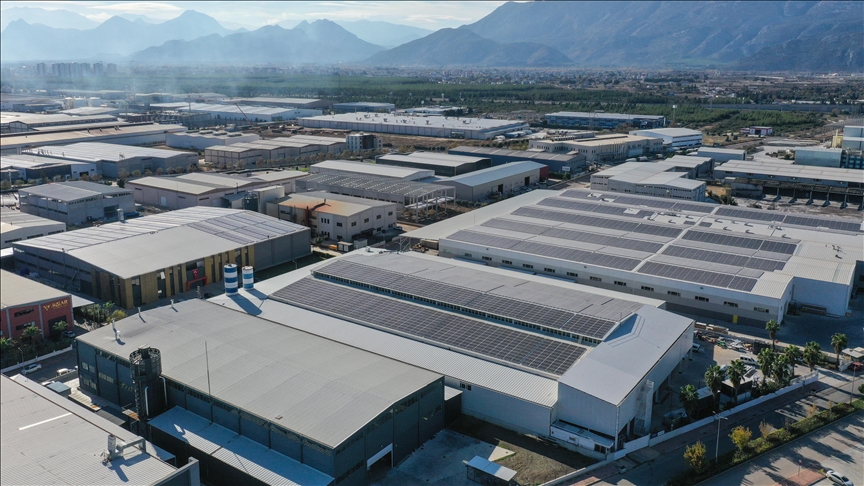

By Anadolu Agency
LONDON
Türkiye’s rooftop solar potential can be expanded by 120 gigawatts which is enough to cover 45% of the country’s total electricity consumption in 2022, according to a report by London-based energy think tank Ember on Monday.
Ember’s analysis used high-resolution satellite images to assess what solar panels can be installed on rooftops outside the 11 provinces of Türkiye declared disaster areas following the Feb. 6 earthquake in the country.
The report assessed the generation potential of optimal-angle roof types for each roof in 70 provinces and found an annual rooftop solar power generation potential of 148 terawatt-hours (TWh).
According to the report, the subsidy amount for households, the consumer type with the lowest electricity tariffs in the country, reached approximately $3.6 billion in the 12-month period from September 2022 to August 2023.
Ember contends that policies encouraging the widespread use of rooftop solar power plants could help lower the actual cost of electricity in the country. Such policies in place would be effective by reducing reliance on imported fossil fuel resources. Additionally, rooftop solar would be more economical and efficient, as it generates power at the point of consumption and does not require land.
Rooftop solar energy potential by cities
According to the report, Türkiye’s rooftop solar potential is close to 10 times its current installed solar capacity, with the top three provinces for total rooftop solar potential being Istanbul with 10.4 gigawatts, Ankara with 10.1 gigawatts, and Izmir with 9.3 gigawatts.
“Although it ranks first in capacity potential, Istanbul, with its production potential of 11.4 TWh, lags behind Ankara at 12.5 TWh and Izmir with 12.4 TWh, both of which have higher solar potential,” the report said.
“Konya, at 8.6 TWh, follows the three largest cities. Manisa with 6.4 TWh, Bursa with 5.4 TWh, Afyon with 5.3 TWh, and Balikesir with 4.7 TWh follow, in line with their capacity potential rankings.
The other two provinces in the top 10 for electricity production are Antalya with 5.5 TWh and Mugla with 4.5 TWh, both of which are ranked higher compared to their capacity potential ranking because of their high solar potential, it said.
Cities like Konya, Ankara, and Izmir have significant rooftop solar generation potential relative to their billed electricity consumption, the report noted.
Nearly half of new solar capacity worldwide is installed on rooftops
Last year, a total of 239 gigawatts of new solar capacity was added worldwide, nearly half of which, at 118 gigawatts, was installed on rooftops.
The newly installed rooftop solar power plants in 2022 increased by 49% compared to the earlier year, and Australia became the top country for solar capacity per capita as of 2022. In Australia, one in every three houses has rooftop solar, according to the report.
“The Netherlands sources 40% of solar generation from residential rooftops,” it added. “In Germany, third for solar capacity per capita globally, over 60% of newly installed solar power plants each year are set up on rooftops, or in some years over 80%. In the European Union, as of the end of 2022, 66% of installed solar capacity was on rooftops.”
Türkiye has rooftop potential that is almost 10 times its installed solar capacity
Quoting Ufuk Alparslan, a regional lead at Ember, the report said: “Rooftops are prioritized in energy transition policies across the world—and for good reason.”
With Türkiye’s ambitious solar targets and a rooftop potential of almost ten times its installed solar capacity, Alparslan maintained that in addition to the current rooftop potential, tens of thousands of new buildings are being constructed every year in Türkiye with the rebuilding effort in the earthquake zone raising this figure even higher.
“Introducing rooftop solar obligations for new buildings and public buildings and the tendering of suitable apartment building roof areas by municipalities can both help Türkiye achieve its energy targets and enable people to generate their own electricity cheaply,” he added.
Türkiye’s solar energy targets
The share of solar in electricity generation in Türkiye increased to 4.7% in 2022, the report said, adding that from January to June this year, the share of solar generation in the country increased to 5.7% compared to the same period last year.
As of the end of November 2023, Türkiye’s solar capacity had increased to 11.2 gigawatts.
In line with the Turkish National Energy Plan announced in 2022, Türkiye plans to increase its installed solar power capacity to 52.9 gigawatts by 2035.
Türkiye’s solar energy installed capacity is expected to reach 30 gigawatts by the end of 2028, according to the country’s 12th Development Plan, published in October 2023. To reach this capacity, the country needs to build 3.4 gigawatts of solar installed capacity every year between 2024 and 2028.
We use cookies on our website to give you a better experience, improve performance, and for analytics. For more information, please see our Cookie Policy By clicking “Accept” you agree to our use of cookies.
Read More